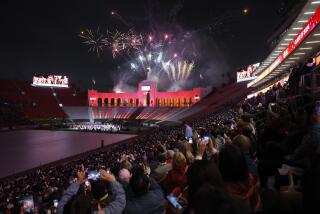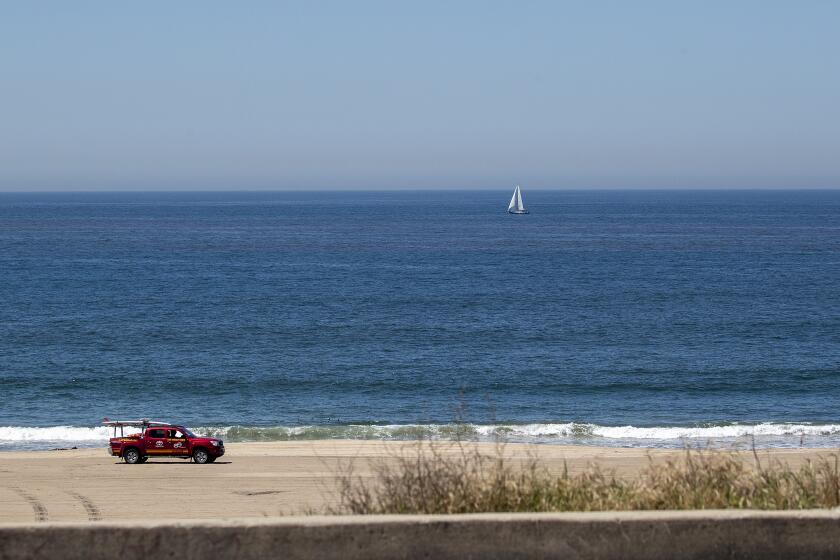Measures to Limit Growth Passing in Carlsbad
Two competing growth-related ballot measures won majorities of the votes Tuesday in an election that could dramatically affect this city’s future.
The two propositions--Proposition G, a tough slow-growth measure, and council-backed Propostion E--were gathering similar majorities. The strong support for the measures indicated the anti-growth mood of Carlsbad voters.
In the race to succeed retiring Mayor Mary Casler, longtime Councilman Claude (Buddy) Lewis was leading Robert Prescott, a former councilman. Councilman Mark Pettine, a strong slow-growth advocate, led the field competing for two council seats.
A pair of ballot propositions, overshadowed by the two growth measures, were facing tough going. Proposition F, which called for city residents to foot a nearly $6-million bill to purchase a eucalyptus grove, was gaining a majority, but was substantially short of the two-thirds vote needed for approval.
Proposition H, a measure calling on City Hall to spend about $3.5 million to build a sports complex, was failing badly in early returns.
While the ballot in Carlsbad was flooded with issues and candidates, the two propositions dealing with growth dominated the election. The factions in the debate demonstrated that the growth issue was probably the most important question to go before the voters since Carlsbad was incorporated more than 30 years ago.
Neither side spared expenses to get its points across. More than $130,000 in campaign contributions was collected by groups advocating various positions in the growth debate. Most of the money went to finance mailers that flooded Carlsbad in the final days of the campaign.
The tug of war over development intensified earlier this year when two citizens’ groups collected more than 5,000 signatures to qualify Proposition G for the ballot. The slow-growth measure, which supporters call a necessary step to prevent the “Los Angelization” of Carlsbad, proposed an annual cap on housing construction. Under the measure, 1,000 residential dwelling units could be built in the city during 1987, 750 units in 1988 and 500 each year thereafter through 1996. At that time, the measure would again appear on the ballot, giving voters the option of extending it for five years.
As an alternative to that slow-growth measure, a majority of the City Council decided to sponsor Proposition E. Backers of that measure claimed the proposition would work in conjunction with the city’s recently passed growth-management plan to help keep city services apace with future development.
In addition, Proposition E mandates a limit of 54,599 housing units in the city, meaning Carlsbad’s population would top out at about 135,000; the current population is 50,000. Finally, the council-backed measure stipulated that, if both propositions pass, the one receiving the highest number of votes becomes law.
During the final weeks of the campaign, a third position emerged in the growth debate. Leaders of the Carlsbad Community Builders Assn., a group of developers and major landowners in the city, began a push for the defeat of both ballot measures. The developers said both would cause problems for the community and threatened lawsuits should either pass.
Proposition F asked voters whether the city should spend $5.95 million to purchase about 52 acres of Hosp Grove, a dense stand of eucalyptus trees on the hills rising from the southern shore of Buena Vista Lagoon. Under state law, the ballot measure needed a two-thirds vote to allow the sale of bonds that would finance acquisition of the land. The proposition called for property taxes to be raised to pay off the debt over a 20-year period.
Proposition H asked voters whether the city should spend $3.5 million for a complex of five baseball fields, four football fields and a community center in Macario Canyon. Supporters of the proposition maintained that the complex would provide needed recreational facilities, but opponents countered that parks are needed in other, more highly populated areas of the city.
The growth issue was the central theme in the races for mayor and two city council seats. Lewis, an incumbent councilman who supported Proposition E, attacked his opponent as a pro-growth advocate, citing Prescott’s record during his term on the council in the early 1980s. Prescott, meanwhile, insisted that he was “a middle grounder” on the growth issue.
In the council race, only Marylynn Brown-Bellman, a planning consultant, refused to take a stand on the two propositions.
Pettine, the incumbent councilman, received support from Proposition G backers along with Albert Mendoza, a retired government administrator, and Lois Humphreys, board president of the Leucadia County Water District. Also backing Proposition G were Pat Holzemer-Runsvold, a teacher; Roger Burke, a training administrator for Southern California Edison Co., and Richard Repasky, a private investigator.
Candidates who supported Proposition E were Eric Larsen, manager of an agricultural cooperative; Dennis Brandmeyer, a real estate broker, and John Mamaux, a former Carlsbad school board member and former city manager of Carlsbad and Del Mar.
More to Read
Start your day right
Sign up for Essential California for news, features and recommendations from the L.A. Times and beyond in your inbox six days a week.
You may occasionally receive promotional content from the Los Angeles Times.






